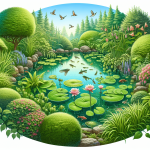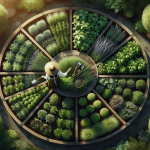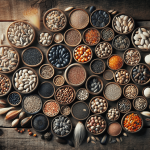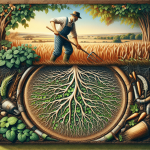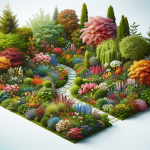This post may contain affiliate links. As an Amazon Associate, we may earn commissions from qualifying purchases.
Imagine stepping outside into your garden and being greeted by a kaleidoscope of fluttering wings – a personal haven for butterflies. Creating a butterfly garden can turn this dream into reality, transforming your outdoor space into a vibrant sanctuary teeming with these enchanting creatures. This guide will explore the essentials of crafting such a magical retreat right in your backyard, from selecting the perfect plants that act as natural magnets for butterflies to understanding the habitat needs that will make your garden a hotspot for these flying jewels. Let’s embark on this delightful journey together, shaping your garden into a bustling paradise for butterflies.
Understanding Butterfly Preferences
Creating a butterfly garden is a delightful way to attract these beautiful creatures to your yard, but first, it’s crucial to understand their preferences. Knowing what butterflies like, from the types of plants they’re attracted to, to the environments they thrive in, will significantly increase your success in creating a haven for them.
Types of butterflies and their specific likes
Different butterflies have unique preferences when it comes to their habitats and food sources. For example, Monarch butterflies are particularly drawn to milkweed plants, where they lay their eggs, and the caterpillars feed on the leaves. Meanwhile, Swallowtails prefer plants like fennel and dill. Recognizing these specific likes is key to attracting a variety of butterfly species.
The importance of sunlight in attracting butterflies
Butterflies are cold-blooded creatures and rely heavily on sunlight to warm their bodies enough to fly. They also use the sun’s rays to navigate and find food. A garden that captures ample sunlight will naturally attract more butterflies. Additionally, planting your garden in a sunny spot encourages healthy growth in plants, providing more nectar for visiting butterflies.
Butterfly life cycle and its implication on garden design
Understanding the life cycle of butterflies—from egg, caterpillar (larva), pupa (chrysalis), to adult butterfly—will guide you in creating a garden that caters to each stage of their lives. For instance, designing your garden to include host plants for caterpillars and nectar plants for adult butterflies ensures a food supply through all life stages, encouraging them to stay and reproduce in your garden.
Choosing the Right Location
Evaluating sunlight exposure
To choose the right location for your butterfly garden, you should assess areas in your yard that receive full sun for most of the day. Ideally, the site should get at least six hours of sunlight daily. Observing your yard throughout the day can help identify the most suitable spot.
Considering wind and shelter
Butterflies are tiny and can easily be blown away by strong winds. Therefore, it’s important to locate your garden in an area protected from strong breezes. Using natural windbreakers such as shrubs, trees, or even buildings can provide the necessary shelter.
Accessibility to water sources
While butterflies do not need large water bodies, incorporating small, shallow water sources like a birdbath with pebbles or a shallow dish can encourage them to visit your garden for hydration and minerals.
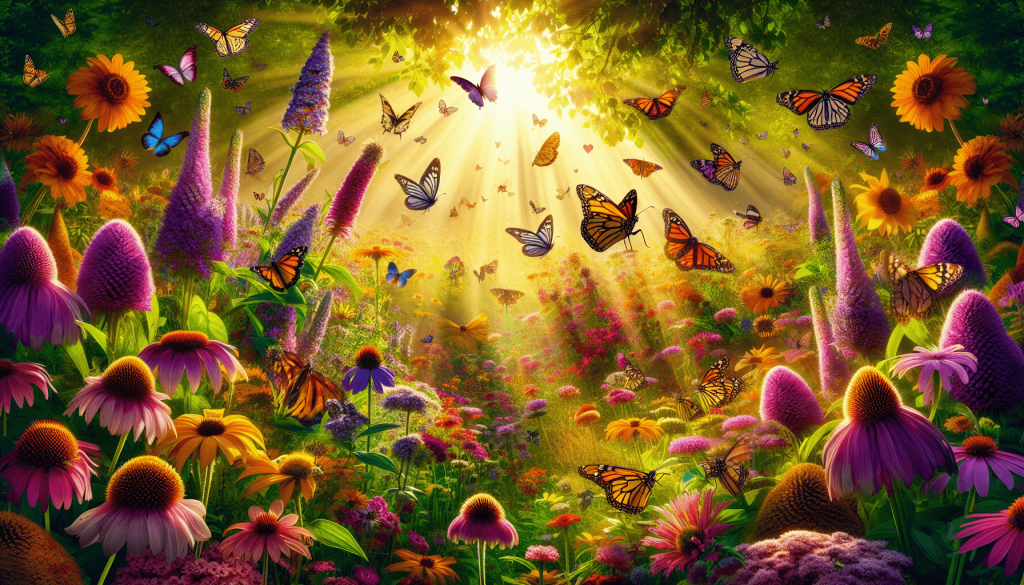
Designing Your Butterfly Garden
Layout planning for various plant heights and colors
A visually appealing and practical layout involves planning for varied plant heights and vibrant colors. Tall plants should be at the back of your garden, with medium and shorter plants in front. This not only creates a beautiful tier effect but also ensures that all plants get adequate sunlight. Vibrant-colored flowers are more likely to attract butterflies.
Incorporating resting spots for butterflies
Butterflies need places to rest, warm their wings, and bask in the sunlight. Flat stones positioned in sunny spots serve as perfect resting places. Additionally, incorporating flat-leaved plants or small branches among the flowers can offer perching spots.
Using natural materials and avoiding pesticides
It’s essential to use natural materials and avoid synthetic pesticides and fertilizers, which can harm butterflies and other beneficial insects. Opting for organic pest control methods and natural soil amendments will ensure a safe environment for butterflies.
Selecting Butterfly-Friendly Plants
Host plants for caterpillars
Including host plants like milkweed, parsley, and dill in your garden will provide a food source for caterpillars, encouraging butterflies to lay their eggs in your garden. Each butterfly species has specific plants that their caterpillars will eat, so researching local butterfly species can guide your plant choices.
Nectar-rich flowers for adult butterflies
Adult butterflies feed on nectar, so planting a variety of nectar-rich flowers is crucial. Flowers like zinnias, butterfly bush, and lavender are excellent choices. Different species have particular preferences, so include a diverse range of plants to attract a variety of butterflies.
Native plants vs. exotic plants
Native plants are those that occur naturally in your region and are typically more beneficial for local butterfly populations. They are well-adapted to your climate and soil, requiring less maintenance. While exotic plants can be used, ensure they are not invasive and still provide benefits to the local ecosystem.

Planting Strategy for Continuous Bloom
Seasonal flowering plants to ensure year-round food
To maintain a constant food source for butterflies, it’s essential to select plants that bloom at different times throughout the growing season. This continuous bloom strategy ensures that your garden will always have flowers that provide nectar from spring to fall.
Succession planting techniques
Succession planting involves staggering the planting of different plants or varieties with varying blooming times. This technique ensures a continuous supply of nectar and host plants for butterflies throughout their active seasons.
Maintaining diversity in plant species
A diverse range of plant species not only attracts a wider variety of butterflies but also supports a healthier ecosystem overall. A mixture of plant types can also increase the garden’s resilience against pests and diseases.
Creating a Water Source
Setting up a butterfly puddling area
Butterflies are often seen gathering on wet soil, mud, or puddles, a behavior known as puddling. They do this to drink water and extract minerals from the soil. Creating a puddling area can be as simple as having a shallow dish filled with sand and keeping it moist. Adding a pinch of salt can mimic the minerals found in natural puddles.
Safe water features for butterflies
Water features, when designed with butterflies in mind, serve as excellent sources of water. A shallow birdbath or a dish with pebbles or rocks for them to land on ensures they can safely drink without the risk of drowning.
Importance of clean and shallow water sources
Maintaining a clean and shallow water source is crucial. Stagnant or deep water can become breeding grounds for pests and pose drowning hazards for butterflies. Refreshing the water regularly and keeping the area clean will make it a safe and attractive place for butterflies.
Incorporating Butterfly Shelters
Using vegetation for natural shelters
Dense shrubbery, tall grasses, and even piles of leaves can provide natural shelters for butterflies. These areas offer protection from predators and harsh weather conditions, making your garden a safe habitat for them.
Building or buying butterfly houses
butterfly houses are another way to offer shelter, especially during harsh weather or for overwintering species. While not all butterfly species will use these houses, they can add an attractive element to your garden and might be used by other beneficial insects.
Shelter placement tips
When placing shelters, consider locations that are protected from strong winds, yet close to food sources. This ensures that butterflies have easy access to shelter when they need it, without having to travel far from their food.
Garden Maintenance Practices
Organic pest control methods
Opting for organic pest control ensures that your garden remains a safe haven for butterflies and other beneficial insects. Methods such as introducing beneficial predators, using insecticidal soaps, and manually removing pests can be effective without the need for harmful chemicals.
Regular pruning and deadheading
Regularly pruning your plants and deadheading flowers (removing spent blooms) encourages healthy plant growth and more blooms, which in turn provides more nectar for butterflies. It also keeps your garden looking tidy.
Soil health and mulching
Maintaining soil health is vital for plant growth and, consequently, for supporting a thriving butterfly population. Adding organic matter to your soil and using mulch to retain moisture and suppress weeds can enhance plant health and reduce maintenance.
Observing and Learning from Your Garden
Keeping a garden diary
Keeping a diary of your butterfly garden’s progress, including which plants are thriving and which butterfly species visit, can be both rewarding and educational. This record-keeping can help you make informed adjustments in future seasons.
Photographing butterflies for identification
Photographing the butterflies that visit your garden not only provides a visual record but also assists with identification. There are many resources and online communities that can help you identify the species and learn more about their habits and needs.
Participation in citizen science projects
Contributing to citizen science projects by reporting your observations can help scientists track butterfly populations and their health. It’s a way to contribute to the broader knowledge base and conservation efforts for these important pollinators.
Legal and Ethical Considerations
Ensuring compliance with local wildlife protection laws
Before introducing plants or butterflies, check local guidelines to ensure compliance with wildlife protection laws. It’s important to preserve local ecosystems and avoid disrupting native species.
Ethical collection and introduction of plants and butterflies
When adding plants or butterflies to your garden, ensure that your actions are ethical and don’t harm local ecosystems. It’s better to source plants from reputable nurseries and avoid capturing wild butterflies to introduce to your garden.
Educating others about the importance of biodiversity
Sharing your knowledge about butterfly gardening and its benefits to ecosystems can inspire others to create their own gardens. Educating the community about the importance of biodiversity and how to support it can have a ripple effect, encouraging widespread conservation efforts.
Creating a butterfly garden is a rewarding endeavor that enhances your yard’s beauty and contributes to the health and preservation of butterfly populations. By understanding butterfly preferences, choosing the right location, and carefully planning and maintaining your garden, you can create a vibrant, life-supporting habitat that attracts these beautiful creatures for years to come.

